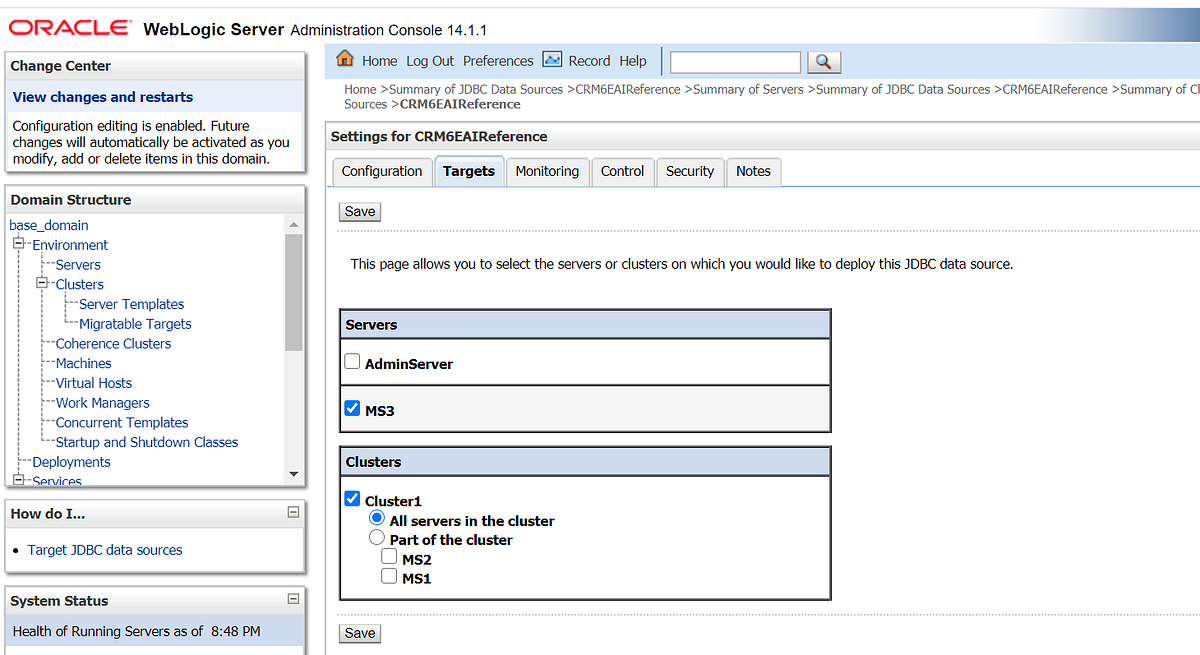Creating Socket Adapter connection factories through WLST script - Oracle SOA Suite
The below WLST script will help us to create the Socket adapter connection factories in Oracle SOA Suite 11g or Oracle SOA Suite 12c
Change the Socket/SOA server details accordingly in the script.
Before executing the script make sure the SocketAdapter is targeted to the servers.
CreateSocketConnectionFactory.py
TargetServerName='AdminServer'
soaHome='C:\EnvSetup\MiddlewareBlog\Oracle_SOA1'
appPathSock=soaHome+'\soa\connectors\SocketAdapter.rar'
appNameSock='SocketAdapter'
moduleOverrideNameSock=appNameSock+'.rar'
SockJNDIName = 'eis/socket/SocketAdapterBlog'
#Socket Sever Details
HostName=
'101.63.203.129'
Password=
'blogenv1'
Port=
'7001'
UserName=
'weblogic'
moduleDescriptorName='META-INF/weblogic-ra.xml'
planPathSock='C:\EnvSetup\MiddlewareBlog\Oracle_SOA1\soa\connectors\Plan_Soket.xml'
def createSocketConnectionFactory():
edit()
startEdit()
startApplication(appNameSock)
myPlanSock=loadApplication(appPathSock, planPathSock)
makeDeploymentPlanVariable(myPlanSock,'ConnectionInstance_eis/Socket_JNDIName_13102979357209', SockJNDIName , '/weblogic-connector/outbound-resource-adapter/connection-definition-group/[connection-factory-interface="javax.resource.cci.ConnectionFactory"]/connection-instance/[jndi-name="'+SockJNDIName+'"]/jndi-name',moduleOverrideNameSock)
makeDeploymentPlanVariable(myPlanSock, 'ConfigProperty_eis/Socket_JNDIName_Host_Name_13102979357210', HostName,'/weblogic-connector/outbound-resource-adapter/connection-definition-group/[connection-factory-interface="javax.resource.cci.ConnectionFactory"]/connection-instance/[jndi-name="'+SockJNDIName+'"]/connection-properties/properties/property/[name="Host"]/value',moduleOverrideNameSock)
makeDeploymentPlanVariable(myPlanSock, 'ConfigProperty_eis/Socket_JNDIName_Port_13102979357212', Port,'/weblogic-connector/outbound-resource-adapter/connection-definition-group/[connection-factory-interface="javax.resource.cci.ConnectionFactory"]/connection-instance/[jndi-name="'+SockJNDIName+'"]/connection-properties/properties/property/[name="Port"]/value',moduleOverrideNameSock)
myPlanSock.save();
save();
cd('/AppDeployments/SocketAdapter/Targets');
updateApplication(appNameSock, planPathSock);
startApplication(appNameSock);
activate(block='true');
def makeDeploymentPlanVariable(wlstPlan, name, value, xpath,overrideName, origin='planbased'):
wlstPlan.destroyVariable(name)
wlstPlan.destroyVariableAssignment(name, overrideName, moduleDescriptorName)
variableAssignment = wlstPlan.createVariableAssignment(name, overrideName, moduleDescriptorName)
variableAssignment.setXpath(xpath)
variableAssignment.setOrigin(origin)
wlstPlan.createVariable(name, value)
print 'moduleDescriptorName=',moduleDescriptorName
def main():
#SOA Server Details
adminURL=
't3://localhost:7001'
adminUserName=
'weblogic'
adminPassword=
'blogenv1'
connect(adminUserName, adminPassword, adminURL)
createSocketConnectionFactory()
disconnect()
main()
Login to the server, cd to the folder where the script is available and execute the script as shown below.
%MIDDLEWARE_HOME%\wlserver_10.3\common\bin\wlst.cmd CreateSocketConnectionFactory.py








